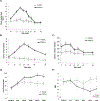Examining reactivity patterns in burnout and other indicators of chronic stress
- PMID: 31003136
- PMCID: PMC6864749
- DOI: 10.1016/j.psyneuen.2019.04.002
Examining reactivity patterns in burnout and other indicators of chronic stress
Abstract
Introduction: Burnout symptomatology is associated with various negative health consequences; however, the mechanisms underlying these associations remain unclear. One potential pathway involves alterations in the acute stress response. The aims of the present study were to examine burnout-associated alterations in stress-reactivity patterns, during a standardized social stressor compared to a control condition, as well as to examine whether effects associated with greater burnout symptomatology were distinct from other, conceptually overlapping indicators of chronic stress (i.e. depressive symptomatology and elevated hair cortisol concentration [HCC]).
Materials and methods: In a randomized two-factor design a total of 70 employed males with varying burnout symptoms but without evidence of physical or psychiatric disease were exposed to the Trier Social Stress Test for Groups (TSST-G) or a non-stressful control condition. Acute stress reactivity was assessed using self-report stress measures and non-invasive biomarkers. Associations among acute stress reactivity, burnout and depressive symptoms (assessed with self-report measures), as well as HCC were analysed using repeated measure ANCOVAs and moderation analysis.
Results: Burnout symptomatology was associated with elevated stress perception independent of the experimental condition. In addition, depressive symptomatology was associated with enhanced anticipatory appraisal, whereas HCC was not related to any subjective stress measure. On a physiological level, burnout and depressive symptomatology, as well as HCC were associated with a pattern of blunted cardiovascular reactivity, however the timing of this effect varied.
Conclusion: Our results indicate burnout-associated modulations in stress reactivity, which diverge, at least partly, from other indicators of chronic stress.
Keywords: Burnout; Chronic stress; Depression; Hair cortisol; Stress reactivity; TSST.
Copyright © 2019 Elsevier Ltd. All rights reserved.
Conflict of interest statement
Conflict of interests
The authors report no conflicts of interest.
Figures



Similar articles
-
Effort-reward imbalance at work is associated with hair cortisol concentrations: Prospective evidence from the Dresden Burnout Study.Psychoneuroendocrinology. 2019 Nov;109:104399. doi: 10.1016/j.psyneuen.2019.104399. Epub 2019 Aug 2. Psychoneuroendocrinology. 2019. PMID: 31394489
-
Hair cortisol as a biological marker for burnout symptomatology.Psychoneuroendocrinology. 2018 Jan;87:218-221. doi: 10.1016/j.psyneuen.2017.07.485. Epub 2017 Jul 23. Psychoneuroendocrinology. 2018. PMID: 28781093
-
Impact of maltreatment on depressive symptoms in young male adults: The mediating and moderating role of cortisol stress response and coping strategies.Psychoneuroendocrinology. 2019 May;103:41-48. doi: 10.1016/j.psyneuen.2018.12.235. Epub 2018 Dec 24. Psychoneuroendocrinology. 2019. PMID: 30640036
-
Differential patterns of HPA activity and reactivity in adult posttraumatic stress disorder and major depressive disorder.Harv Rev Psychiatry. 2009;17(3):184-205. doi: 10.1080/10673220902996775. Harv Rev Psychiatry. 2009. PMID: 19499418 Review.
-
Examination of peripheral basal and reactive cortisol levels in major depressive disorder and the burnout syndrome: A systematic review.Neurosci Biobehav Rev. 2020 Jul;114:232-270. doi: 10.1016/j.neubiorev.2020.02.024. Epub 2020 Feb 20. Neurosci Biobehav Rev. 2020. PMID: 32088345
Cited by
-
The association between hair cortisol and burnout is moderated by age, psychosocial, and immunological markers.Brain Behav Immun Health. 2024 Nov 23;43:100909. doi: 10.1016/j.bbih.2024.100909. eCollection 2025 Feb. Brain Behav Immun Health. 2024. PMID: 39717874 Free PMC article.
-
The STRESS-EU database: A European resource of human acute stress studies for the worldwide research community.Neurosci Appl. 2024 Apr 4;3:104063. doi: 10.1016/j.nsa.2024.104063. eCollection 2024. Neurosci Appl. 2024. PMID: 40656059 Free PMC article.
-
Respiration rate during a stress task moderates neuroticism and perceived stress in older adults.Curr Issues Personal Psychol. 2022 Mar 17;10(4):299-310. doi: 10.5114/cipp.2022.114143. eCollection 2022. Curr Issues Personal Psychol. 2022. PMID: 38013730 Free PMC article.
-
Maternal Mental Health and Parenting Stress and Their Relationships to Characteristics of the Child With Fragile X Syndrome.Front Psychiatry. 2021 Nov 24;12:716585. doi: 10.3389/fpsyt.2021.716585. eCollection 2021. Front Psychiatry. 2021. PMID: 34899411 Free PMC article.
-
Association Between Phasic Vagal-Mediated Heart Rate Variability and Momentary Exhaustion in Daily Life.Stress Health. 2025 Aug;41(4):e70074. doi: 10.1002/smi.70074. Stress Health. 2025. PMID: 40693838 Free PMC article.
References
-
- American Psychiatric Association, 2000. Diagnostic and Statistical Manual of Mental Disorders, fourth ed Author, Washington, DC: 10.1176/appi.books.9780890423349. - DOI

